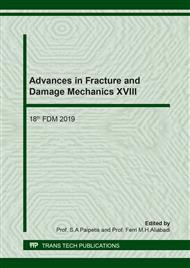p.330
p.336
p.343
p.349
p.355
p.361
p.367
p.373
p.379
Prediction of Indentation Size Formed by a High-Velocity Impingement of a Solid Sphere Based on an Expanding Cavity Model
Abstract:
The fan blades and turbine blades in a jet engine are seriously damaged by high velocity impingements of various foreign objects. In this study, a prediction method of indentation size formed by a high-velocity impingement of a solid sphere (PMIS) was developed from a theoretical model based on an expanding cavity model and energy conservation before and after impingement. The Johnson-Cook constitutive equation was employed to introduce effects of work hardening, strain rate hardening and thermal softening into the cavity model. As a result, the distribution of equivalent plastic strain, equivalent plastic strain rate, temperature and equivalent von Mises stress estimated using the expanding cavity model was in good agreement with the data obtained from the finite element analysis. In addition, it has been demonstrated that PMIS can accurately predict the radius of indentation formed on various metallic materials subjected to the impingement of a solid sphere with the radii of 0.75, 1.5 and 3 mm at several impact velocities from 50 to 300 m/s.
Info:
Periodical:
Pages:
355-360
Citation:
Online since:
December 2019
Authors:
Price:
Сopyright:
© 2020 Trans Tech Publications Ltd. All Rights Reserved
Share:
Citation:


